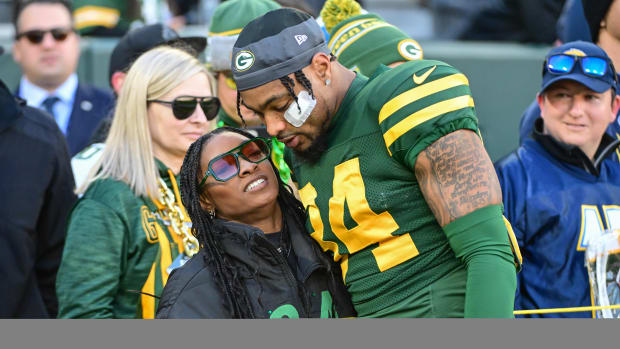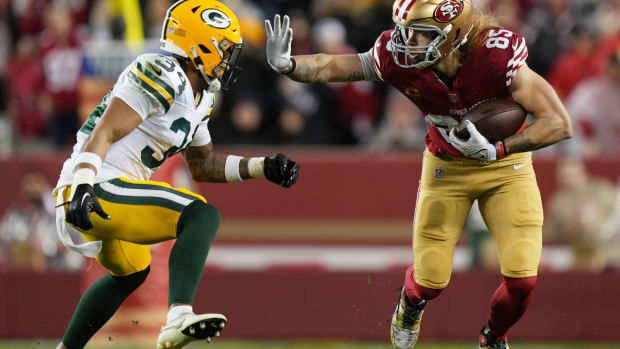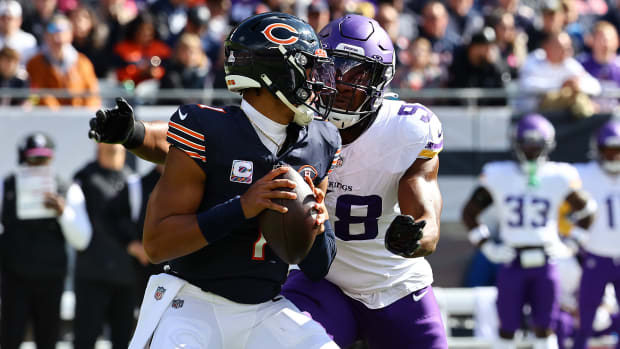Justin Fields Not Alone Among Improved Bears
Unlike in baseball or basketball, a football player's individual output can't always be traced by a stat line.
It's true with the offensive line and even to an extent at other offensive positions because one of the most critical aspects of the sport is very subjective—blocking.
Blocking is difficult to assess but websites like Pro Football Focus make an attempt.
It's here where some of the better play for the Bears occurred over the 2022 season.
The Bears had improvement in 2022 even if it didn't always show up in stats and definitely didn't show in their win total. Here were the most improved Bears players.
7. CB Kindle Vildor
Despite some apparent improvement, he didn't really appear to secure a job for 2023 because some of the younger undrafted players who came into the lineup after hie suffered a season-nding finger injury played at least as well. Despite missing six games he had career highs of five pass defenses, 3.1 tackles per game and made his first career interception. He also lowered his passer rating against when targeted to a career-best 110.1 and completion percentage allowed to a career-best 65.8%. Both of those figures looked much better until his final two games.
6. C Sam Mustipher
Often a scapegoat for fans on social media thanks to a couple of bad plays on highlight clips, Mustipher improved greatly as a run blocker according to Pro Football Focus' grading. He had not been a favorite of theirs the first two years he made starts but in 2022 raised his overall grade by 12.4 points to 63.4 and was ranked 17th in the league. His run blocking grade went from 46.4 to 63.4, which was 18th in the league.
Mustipher allowed two sacks and had four penalties. They needed him to succeed because Lucas Patrick didn't work out as they had hoped due to injuries.
Now the question is how far his success went, because he's a restricted free agent who was undrafted. That means he's basically unrestricted because his year wasn't so good that the Bears would be likely to tender him an offer that would require teams to pay them draft pick compensation, especially when they also have Patrick and rookie Doug Kramer under contract.
5. RB Khalil Herbert
His 5.7 yards per carry led the NFL for running backs who had a qualifying number of carries.
Yet, he only carried 129 times, 26 more than last year, because of injury. After 731 yards on only 129 carries, it's valid to wonder if he could be a lead back and what he'd do with about 200 carries. However, it must be pointed out much of his success occurred when Justin Fields was running well and he was benefiting from defenses focusing on the quarterback when they used RPOs.
As a receiver, Herbert remained downright bad. Pro Football Focus graded him ahead of only seven other backs as a receiver out of the 60 they scored. He did improve as a pass blocker, though, and only 28 backs rated better doing this than he did.
4. G Teven Jenkins
Taking on a new position and succeeding with trade rumors in the air showed how much resolve Jenkins had. It would appear he has earned his spot at right guard going forward. At least according to PFF grades, he did plenty to show he could handle guard instead of tackle.
"We have a lot of cap space and a lot of opportunities in this draft, so I really don’t know how it's gonna go," Jenkins said. "I don't ever wanna be the person that says, 'yeah, I have a spot.' I always want to stay hungry and feel like I still have to chase my job even if I have it secured."
Chris Lindstrom of the Falcons and Joel Bitonio of the Browns were the only two guards in the entire league who received overall PFF blocking grades better than Jenkins, who was also graded as the third-best run blocker at his position in the NFL.
While his grades look high, he also had the fewest plays on offense of the top 13 guards who were graded. So he still needs to prove he can play without injuries and at a high level.
3. TE Cole Kmet
After going 31 straight games without a touchdown catch, Kmet came up with a team-high seven and stepped up when other receivers were stepping away or out. With no other tight ends delivering and with Darnell Mooney out injured, Kmet had enough production to lead the team with 50 receptions and with 286 yards after the catch. He averaged 10.9 yards per reception. By making 72.5% catches on targets he ranked second among the top 11 pass catchers at tight end. While his overall numbers dropped from last year, he was making more impact receptions. Last year his totals got padded by a number of catches in games with the Bears in catch-up mode. But more than his receiver, Kmet improved as a blocker.
PFF graded him the ninth best run blocker among all tight ends.
"When I look at like myself on tape, just like the steps I've been taking in the run game, pass game, all those things, my focus every week has been just getting a little bit better at something each and every day," Kmet said. "And when you do that and you’re able to stack days like that, you look back to Week 1 and you look back to OTAs, you can really see those steps and how you've grown throughout the course of the season."
2. QB Justin Fields
Fields improved in virtually every way over his rookie year and in some ways numbers can't measure.
"Man, I'm very impressed with his resiliency and his grit and how he fights, how he works," coach Matt Eberflus said. "He really is able to take a great play and also a play that wasn't too good and move to the next one. That's a great quality to have as a leader.
"I saw him really come out of his shell a little bit. The first couple games you saw him come out, as soon as he started to perform and make these plays that he is capable of, you really started to see his leadership grow during that time. That's what really was most impressive."
Fields doubled his touchdown percentage from 2.6 to 5.3, had 17 TDs to seven last year, lowered his interception percentag to 3.5%, improved his passing accuracy from 58.9% to 60.4%, was better in yards per attempt at 7.1 after 6.9 las tyear and his quarterback rating climbed to 85.2 from 73.2.
The thing he couldn't do was improve the team's win total, but he did improve as a rusher, as well. The skills he displayed as a breakaway running threat were rarely apparent as a rookie when he had 420 yards on 72 rushes. Threatening the quarterback rushing record with 1,143 yards on 160 runs put him ahead of anything Michael Vick ever did as a runner and behind only Lamar Jackson. His 178-yard day against Miami is the NFL record.
Fields still needs improvement as a short or intermediat passer.
"I've always said this—his deep ball passing has always been good," Eberflus said. "He's always thrown those very well. The intermediate passing is getting better, his pocket presence is getting better."
1. S Eddie Jackson
No player showed more dramatic improvement to an elite level of play than their two-time Pro Bowl safety. With four interceptions, he was well on his way to a third Pro Bowl berth and first since 2019 when he suffered a season-ending foot injury with five games to go.
Jackson had the lowest completion percentage allowed (61.8) that he's had since 2019, and dropped his passer rating against when targeted to 66.4, also his lowest since 2019. His passer rating against in 2021 had been a career-worst 143.6 and he allowed as many touchdown passes that year (6) as he has in all the other four years he played put together.
In 2022 he dropped the TDs allowed from six to one. Jackson also was hitting. He had 80 tackles through 12 games. At that pace he'd have gone well over 100 tackles. He finished only two from a career best despite missing the last five games.
Twitter: BearDigest@BearsOnMaven





